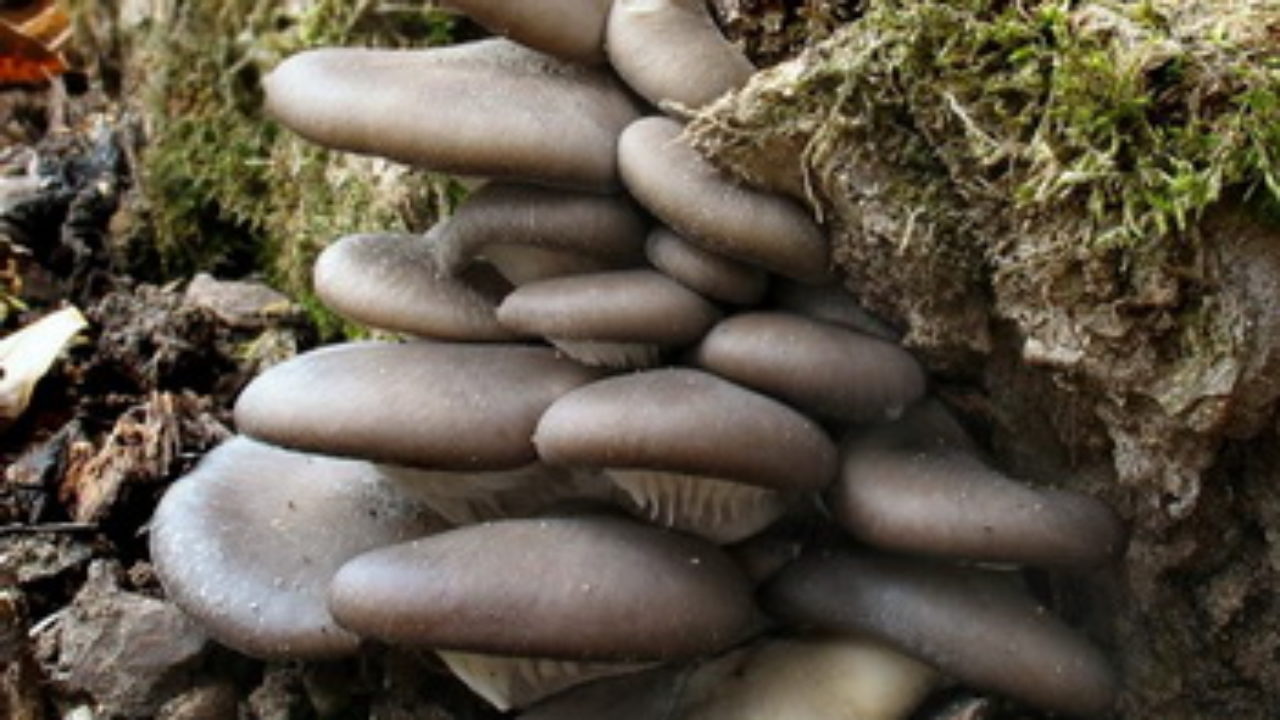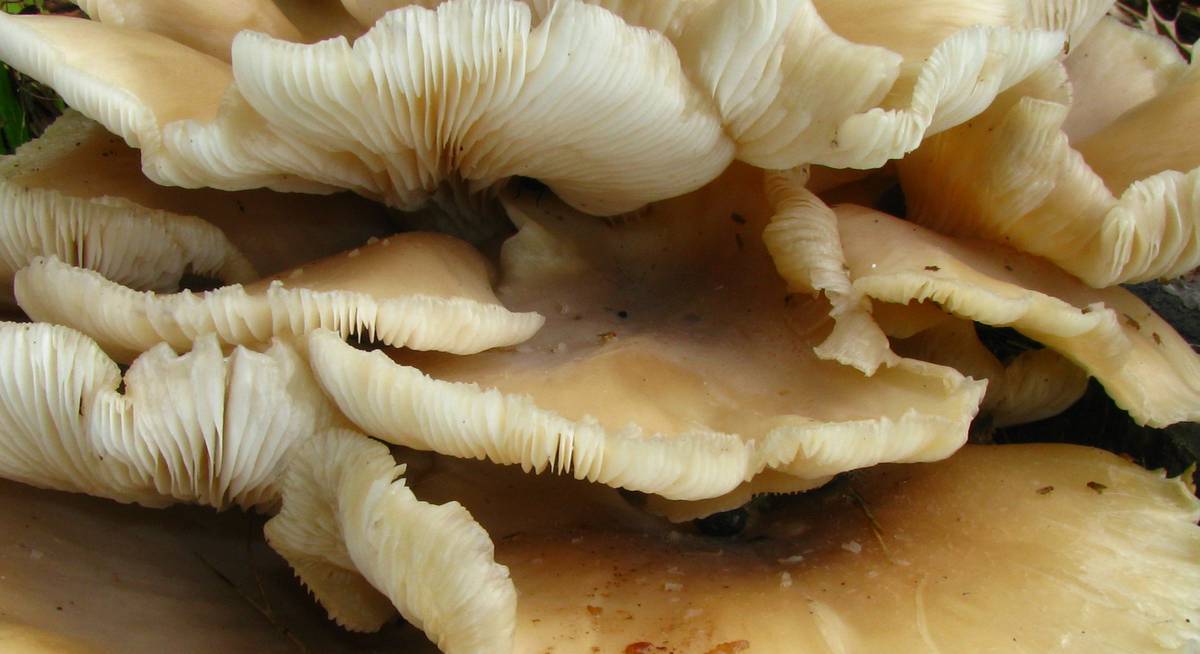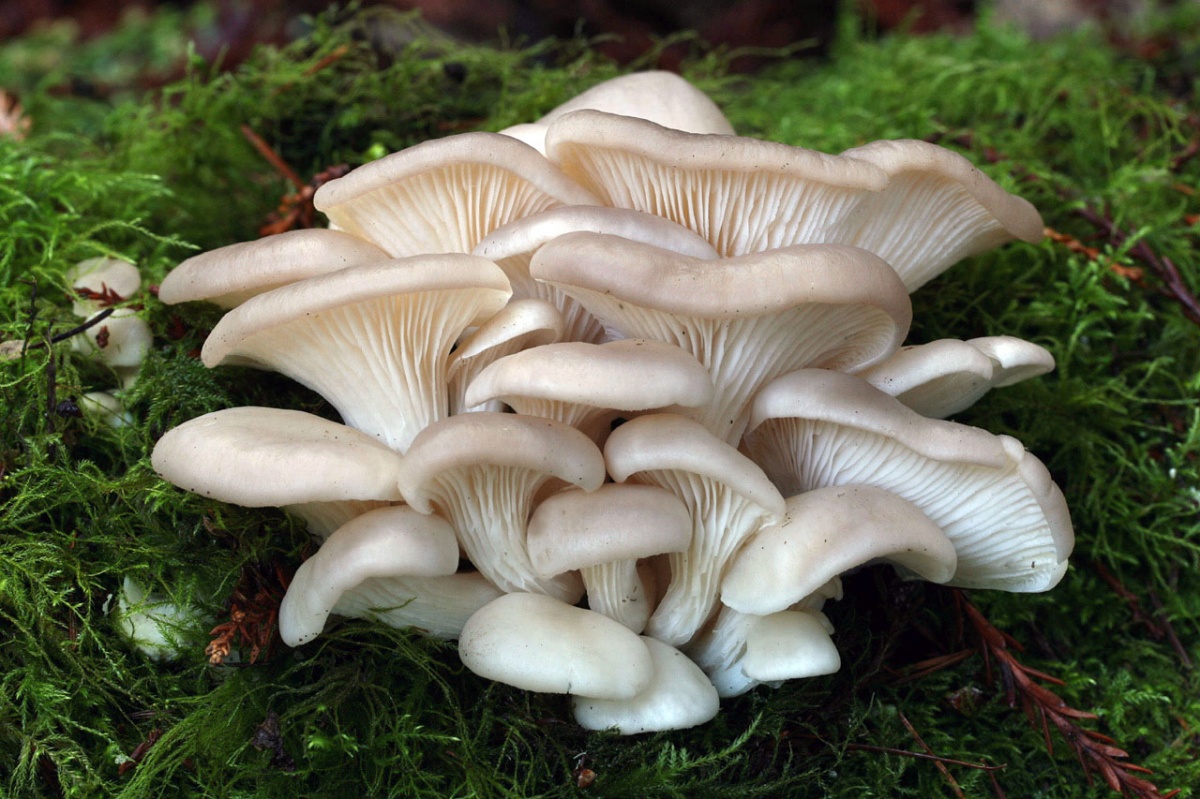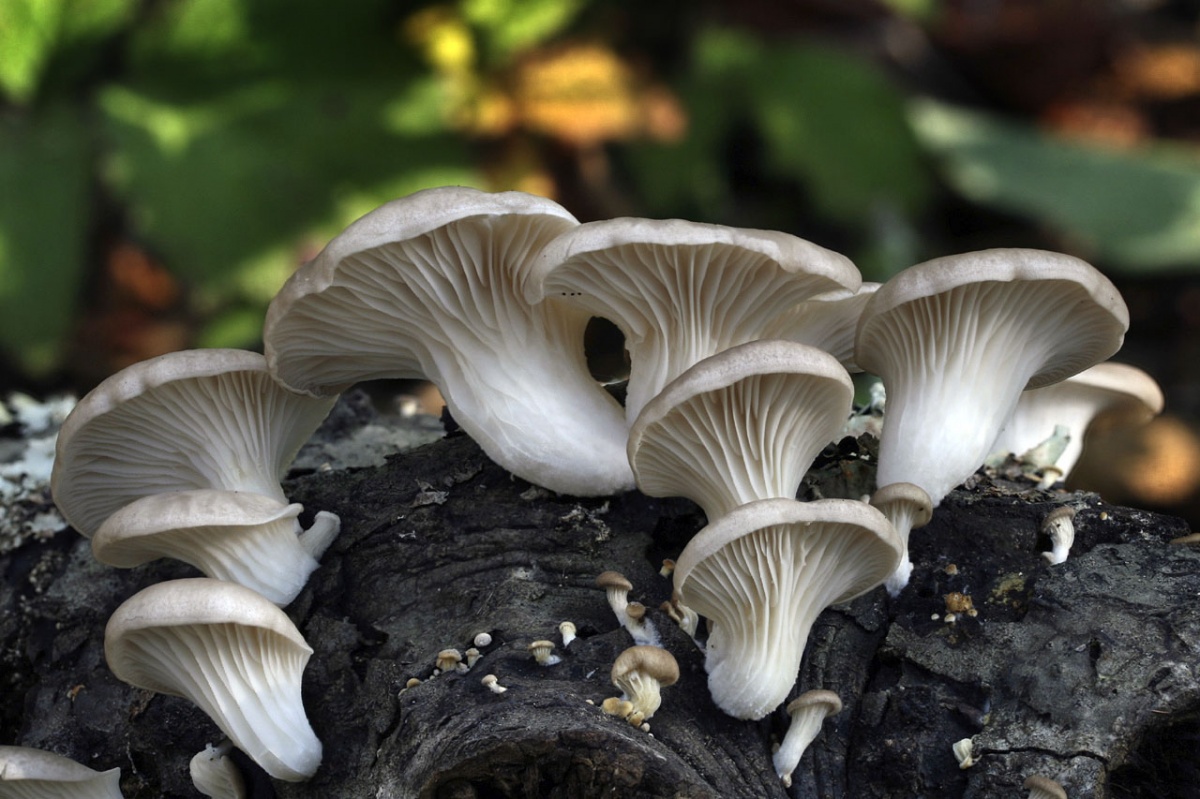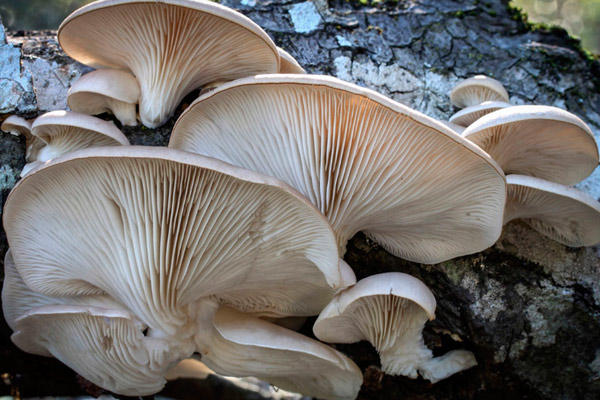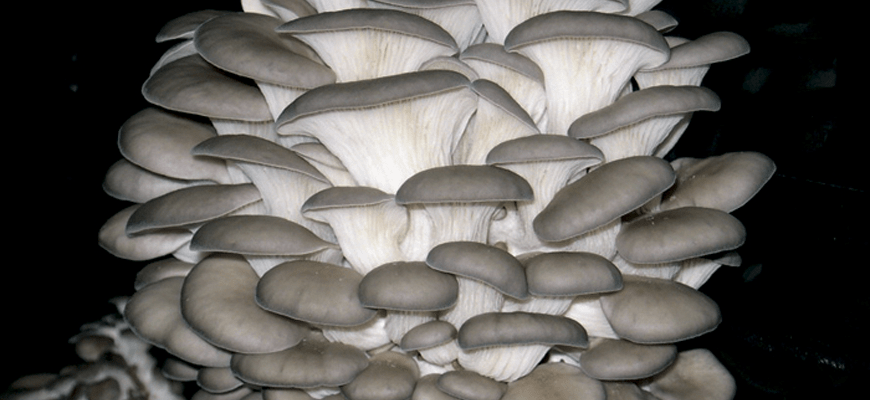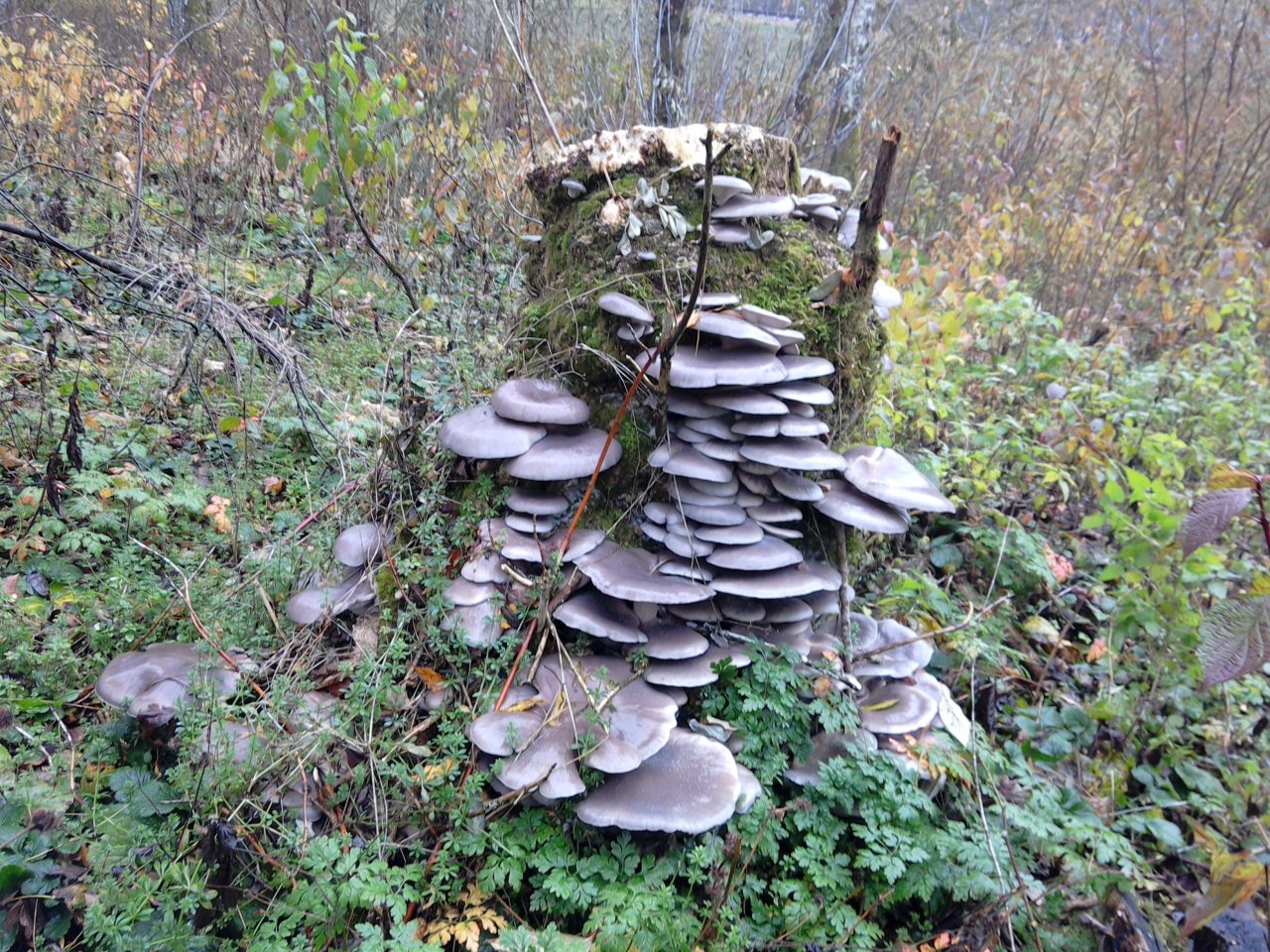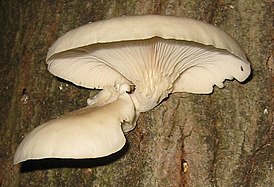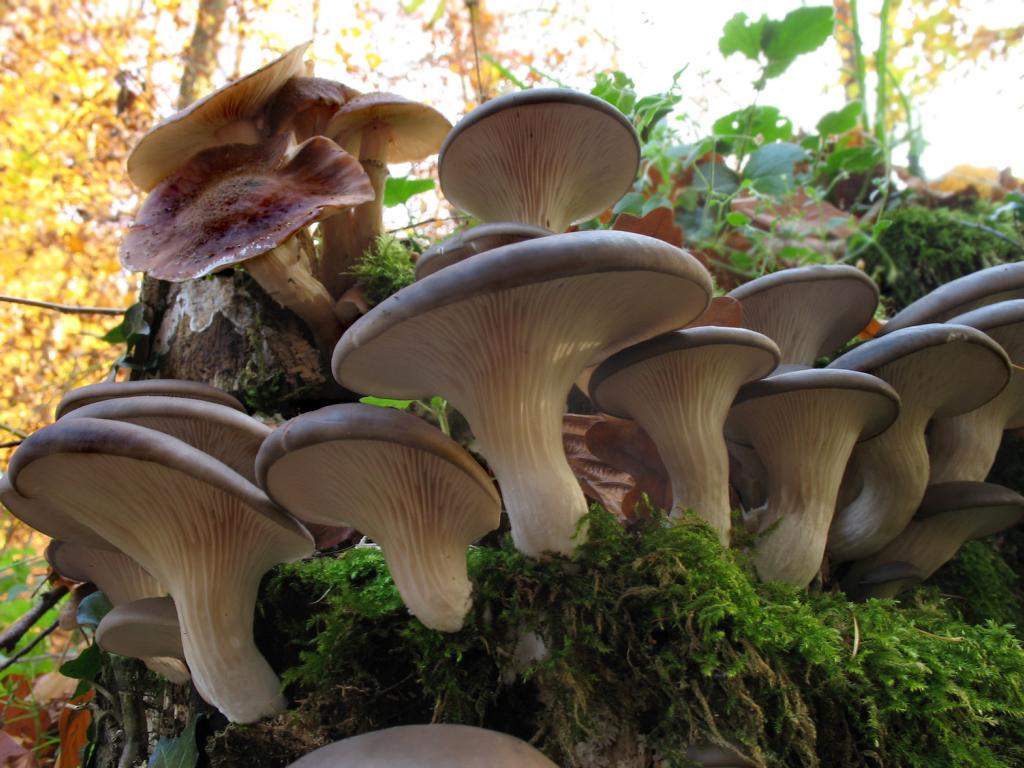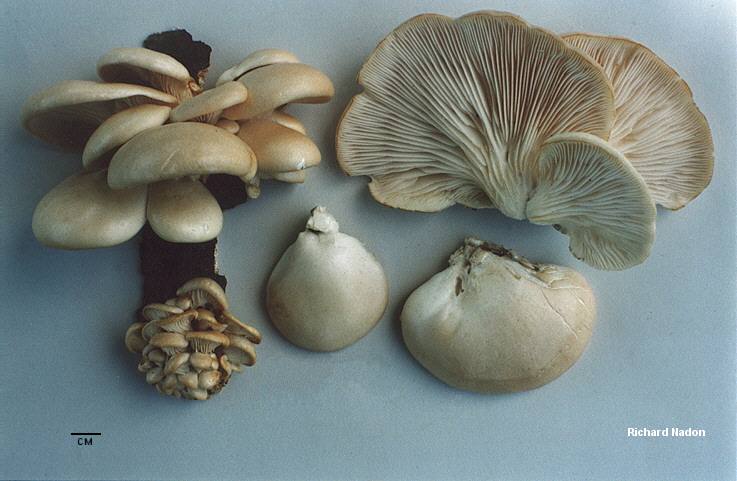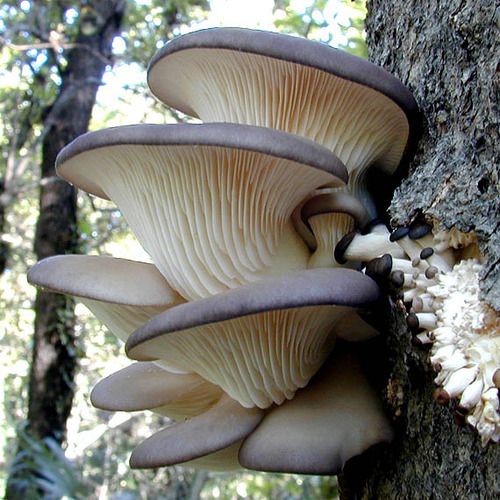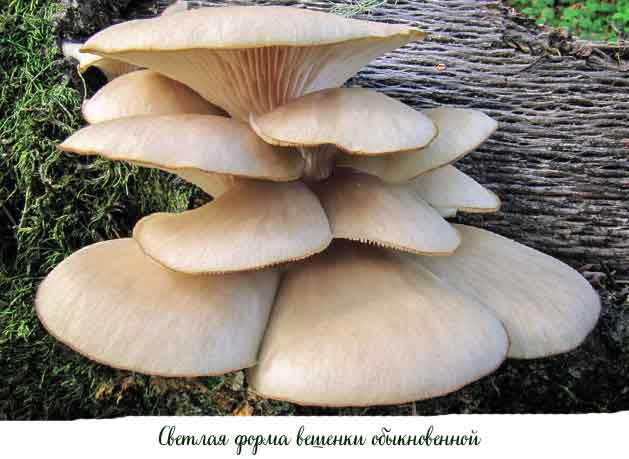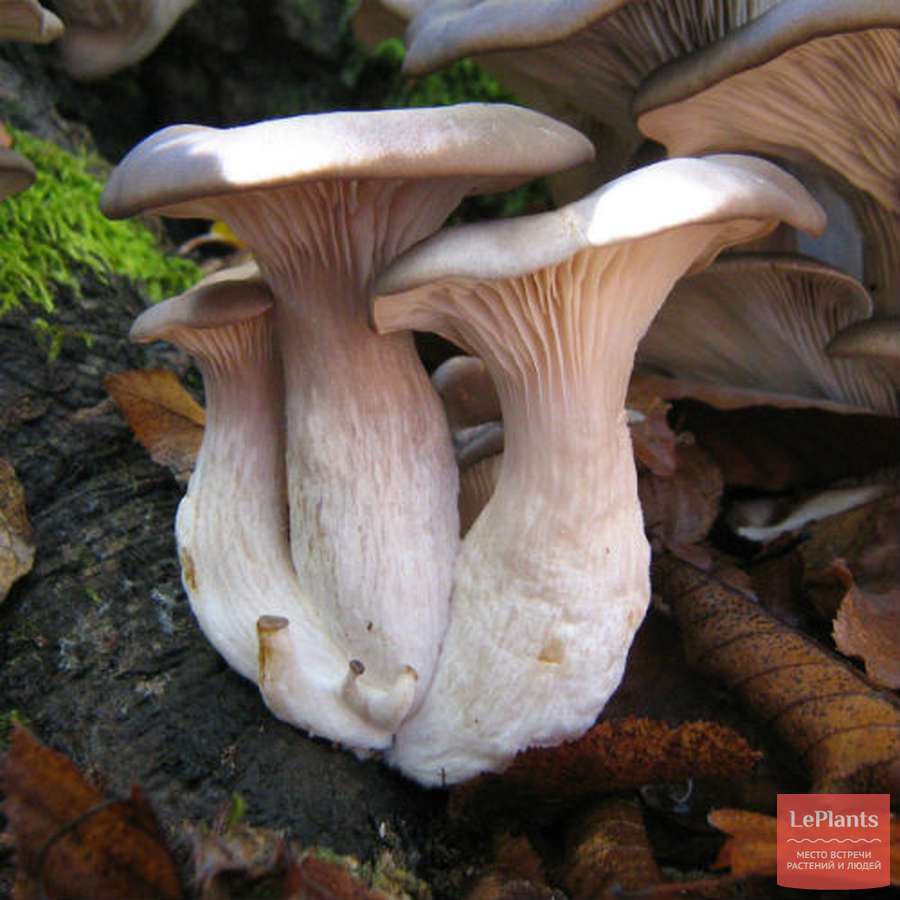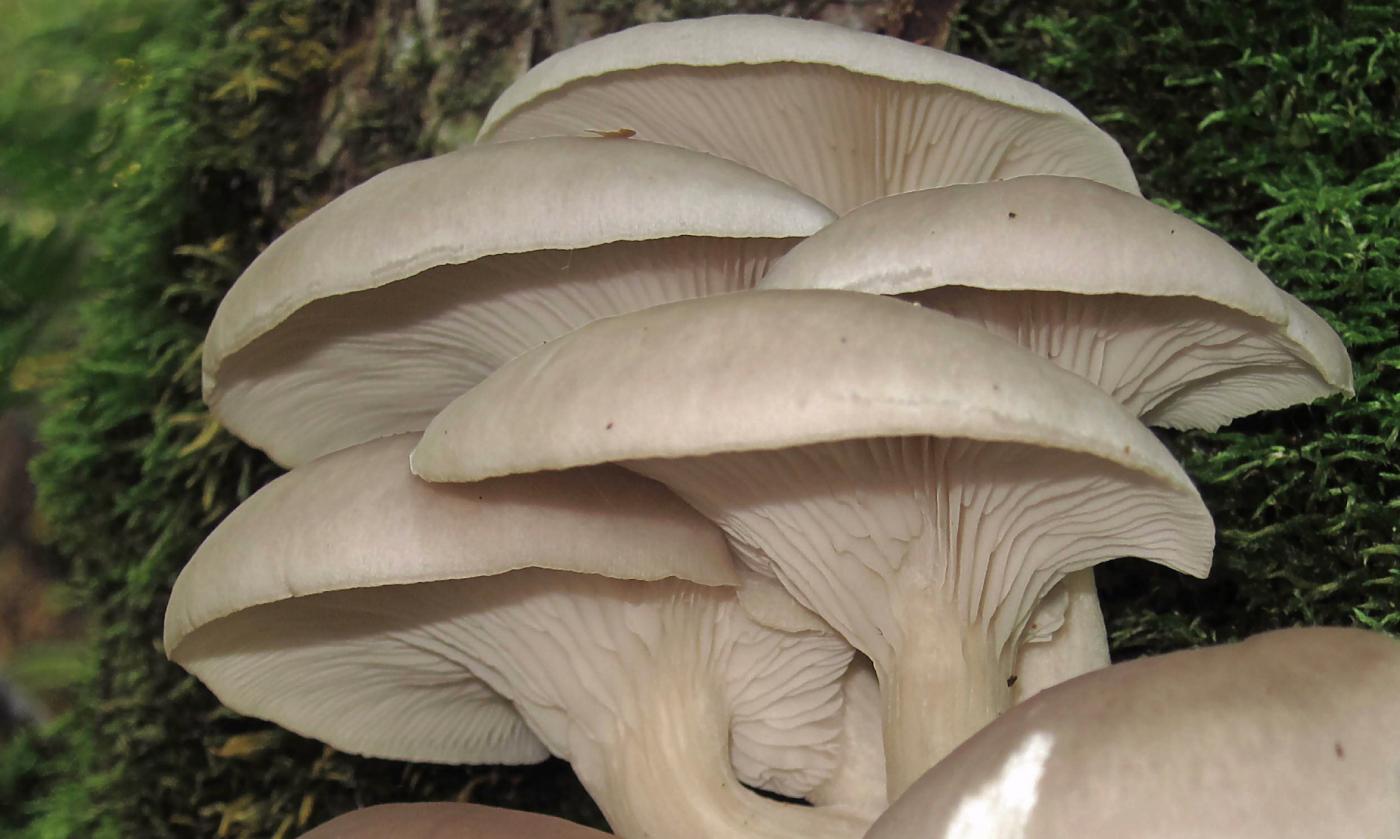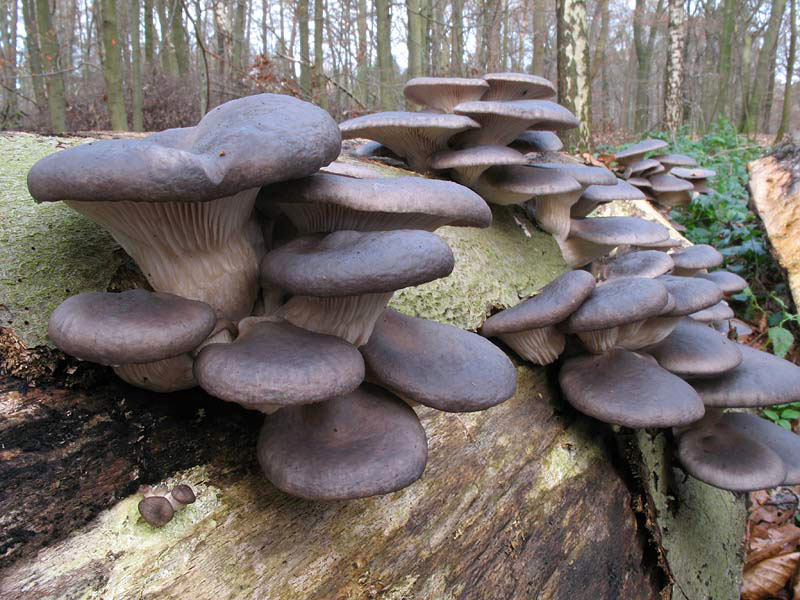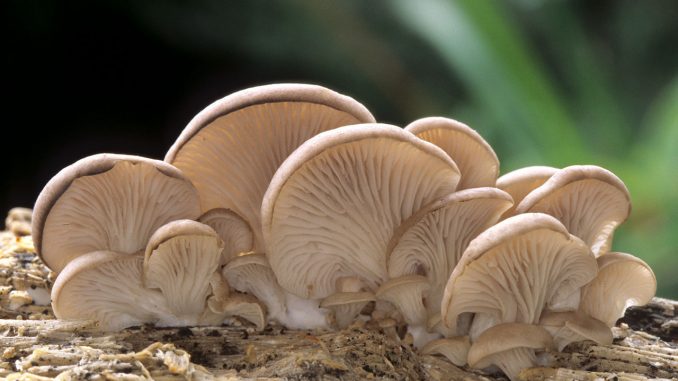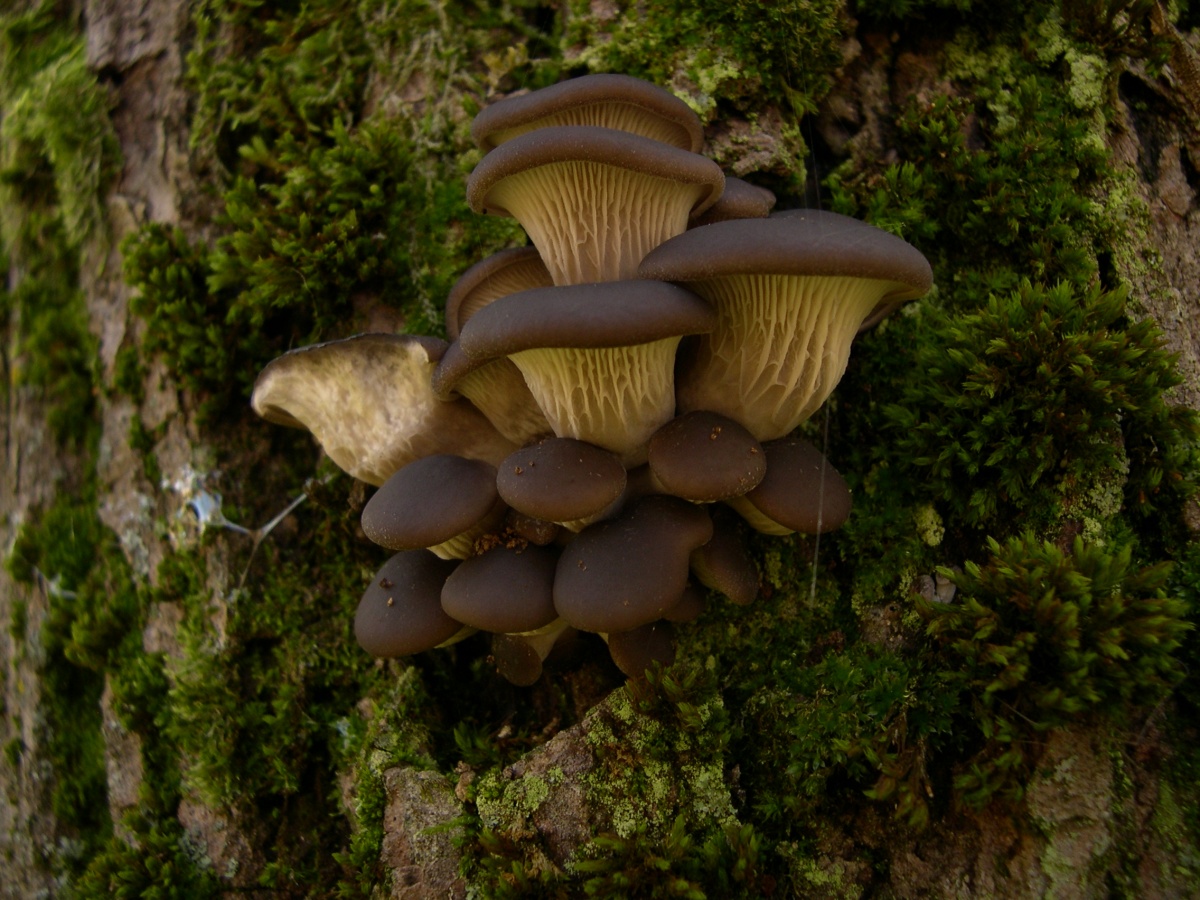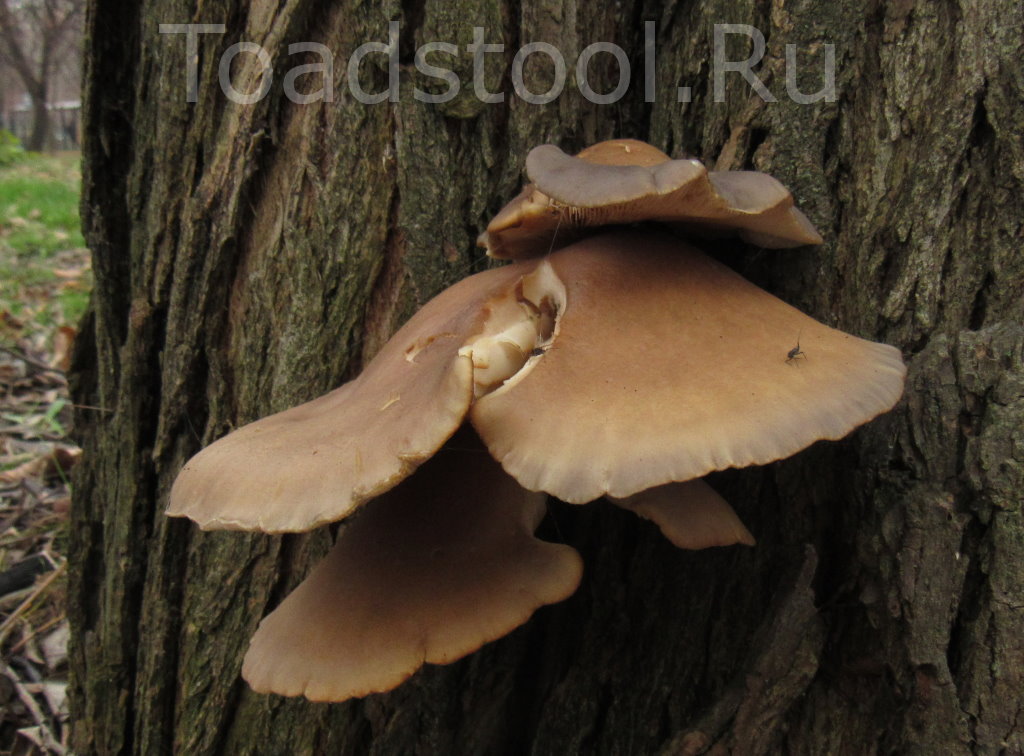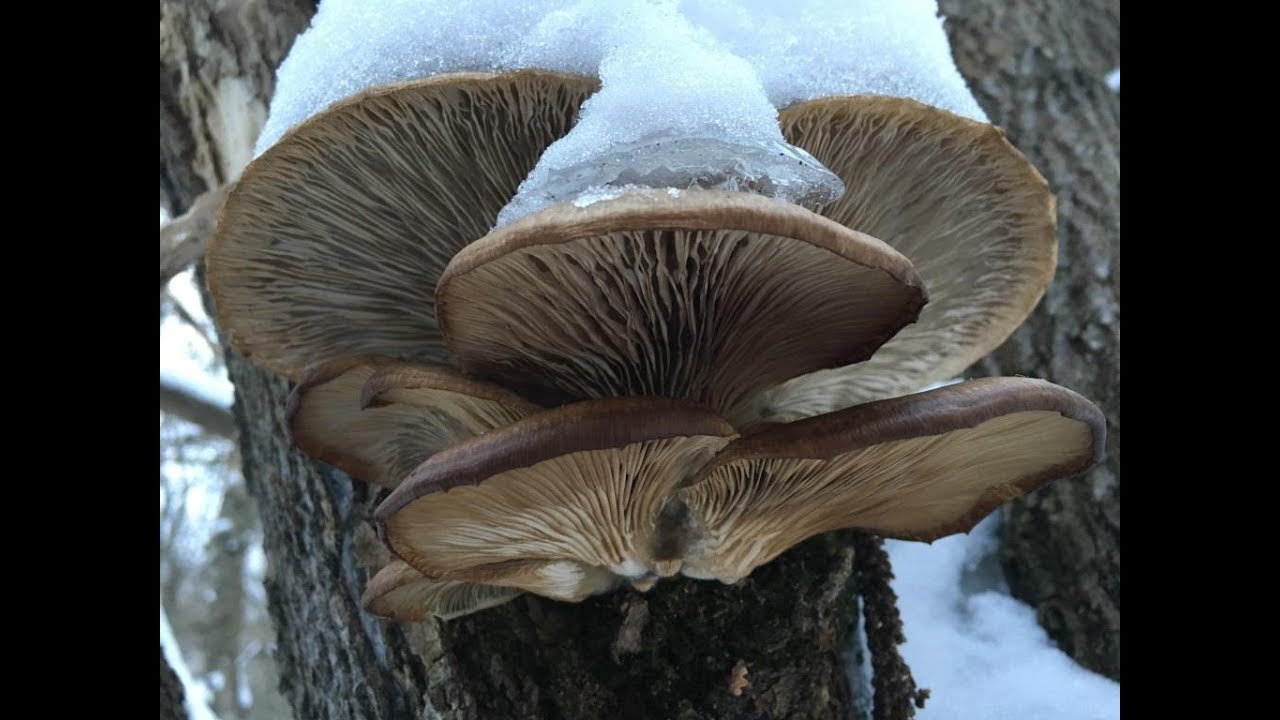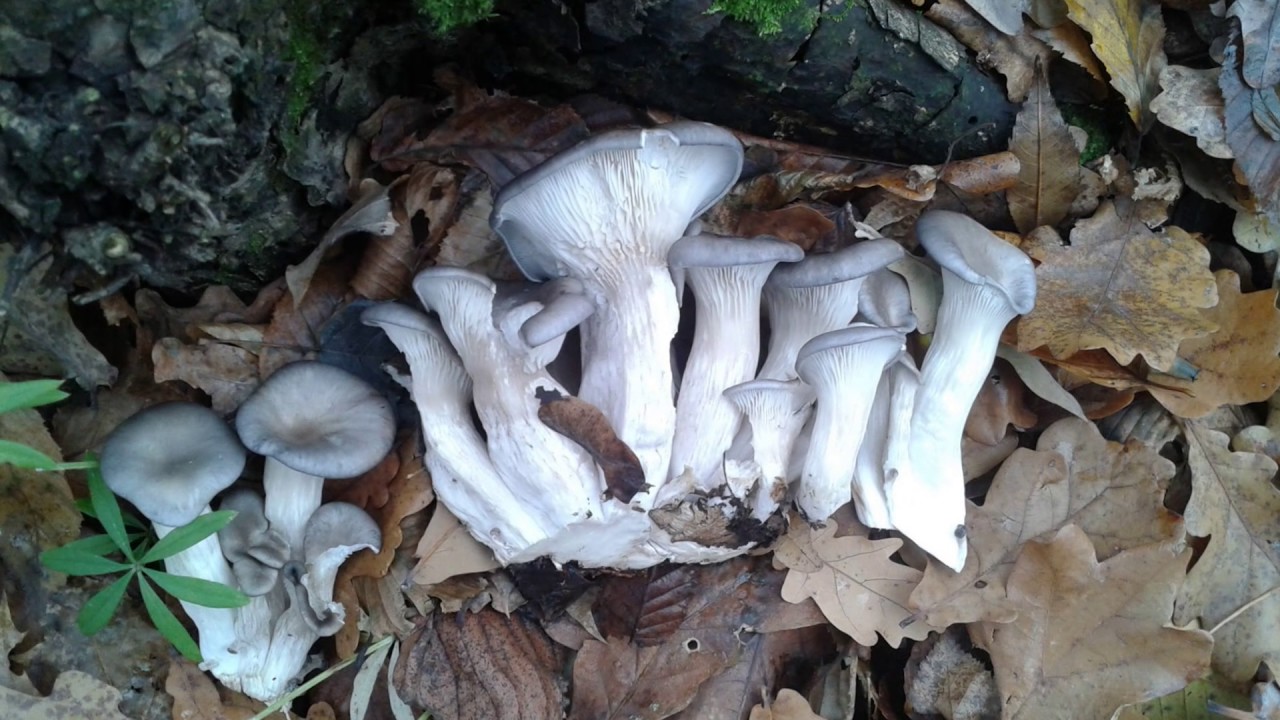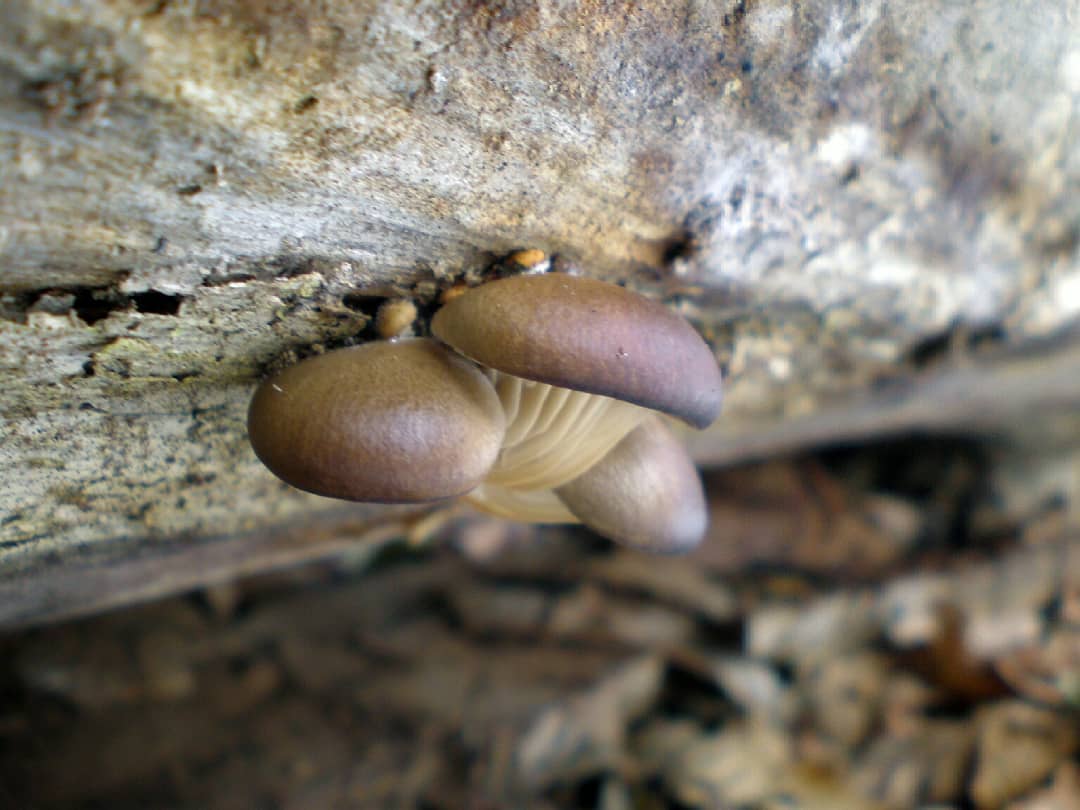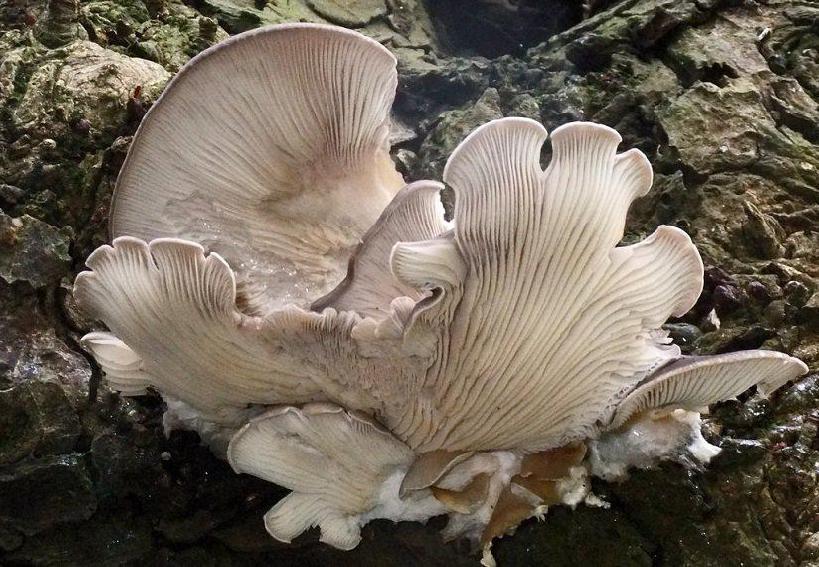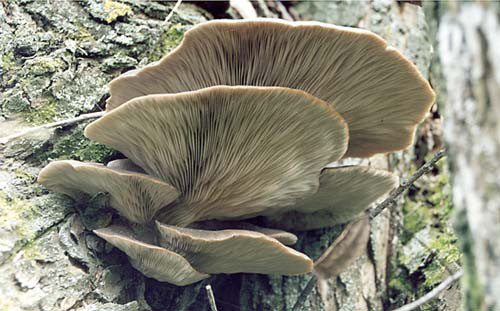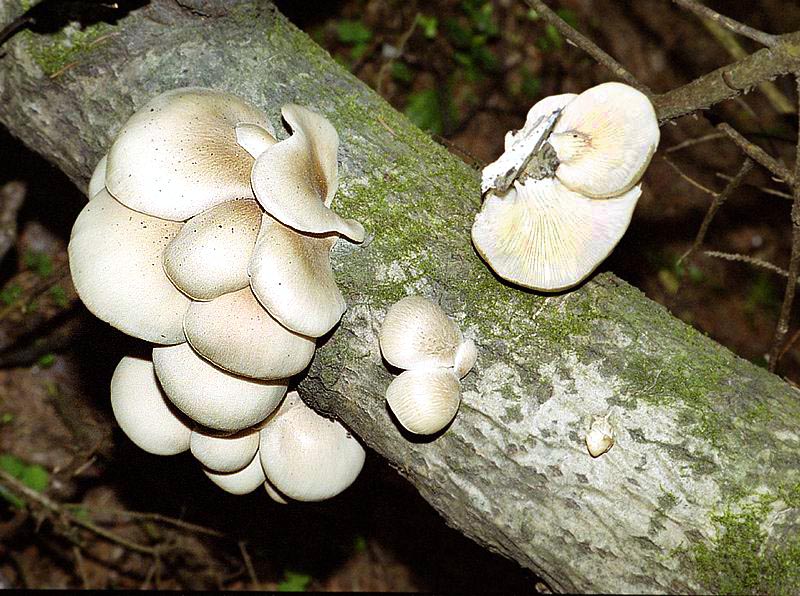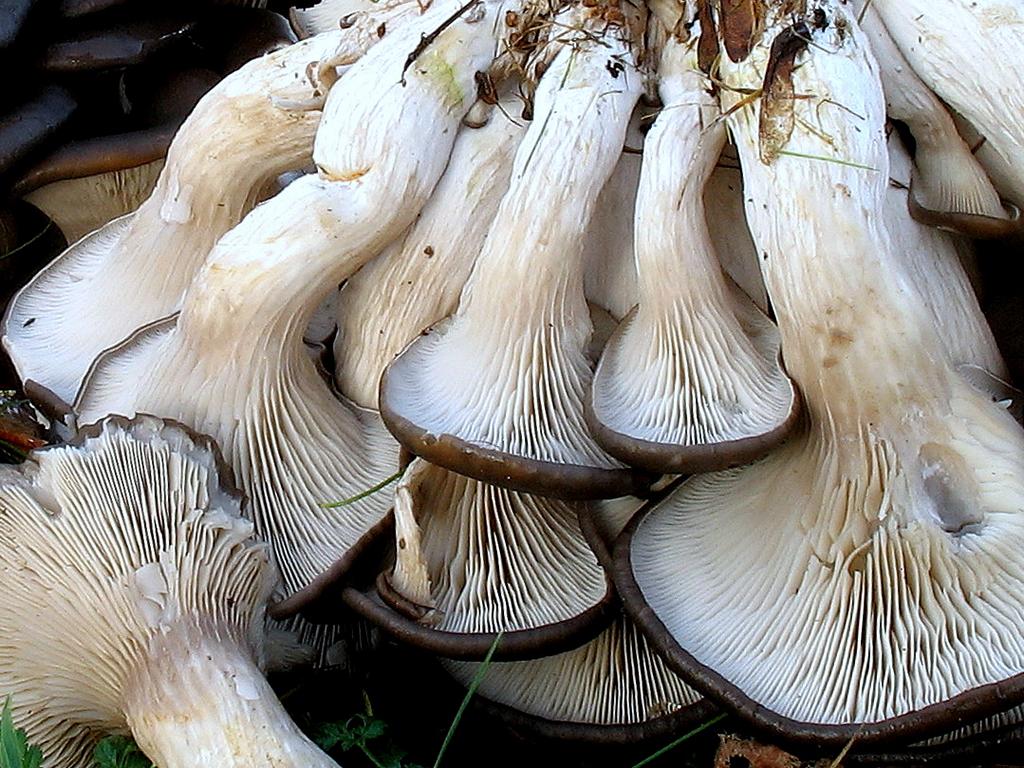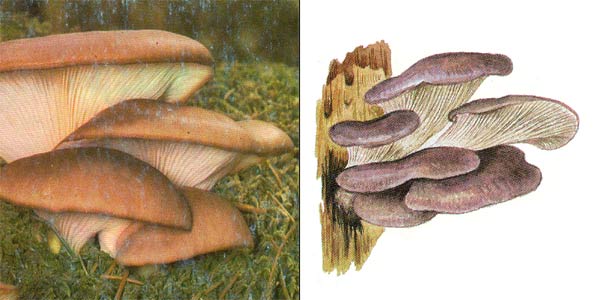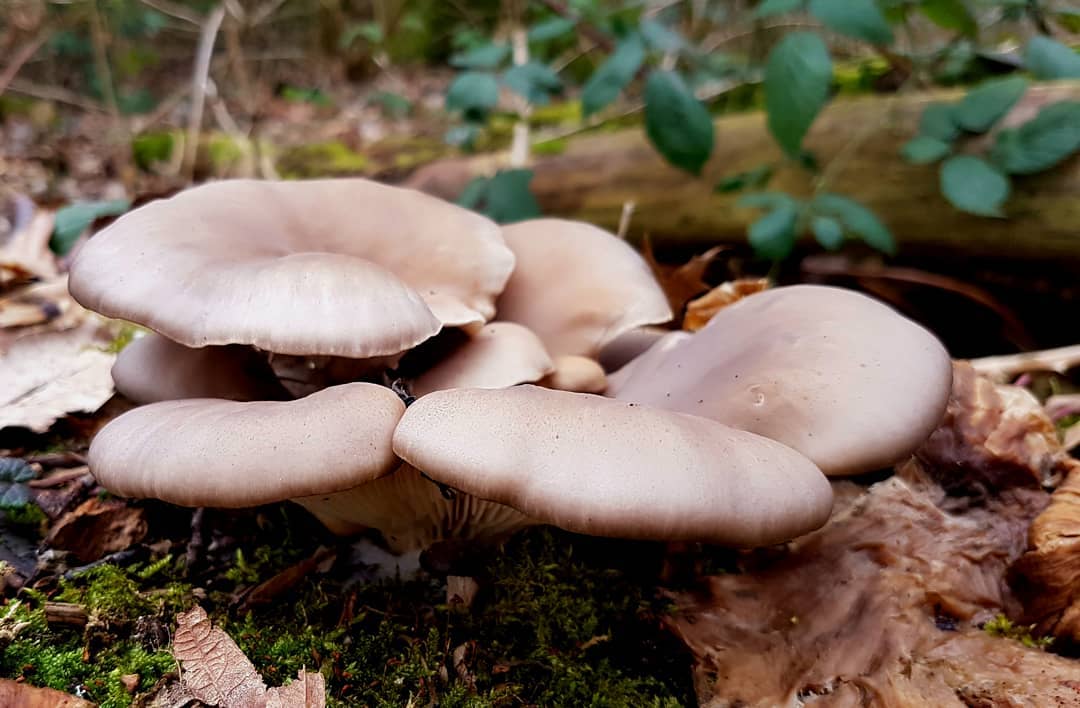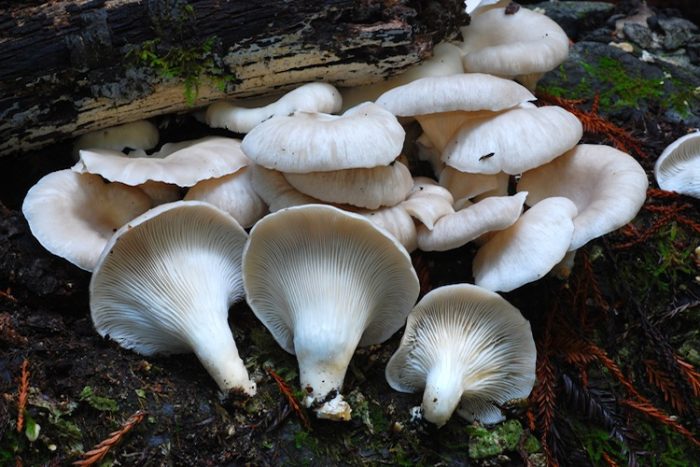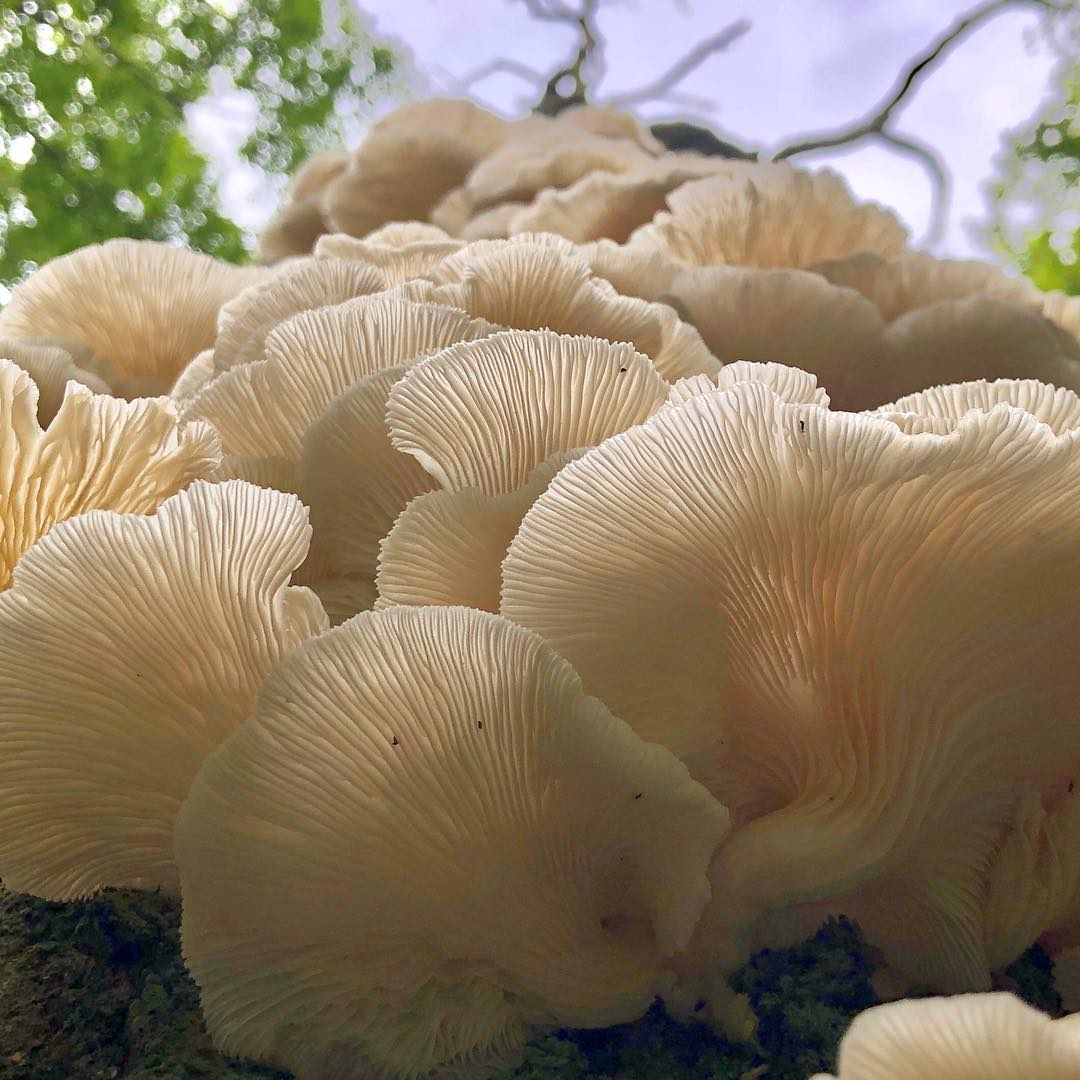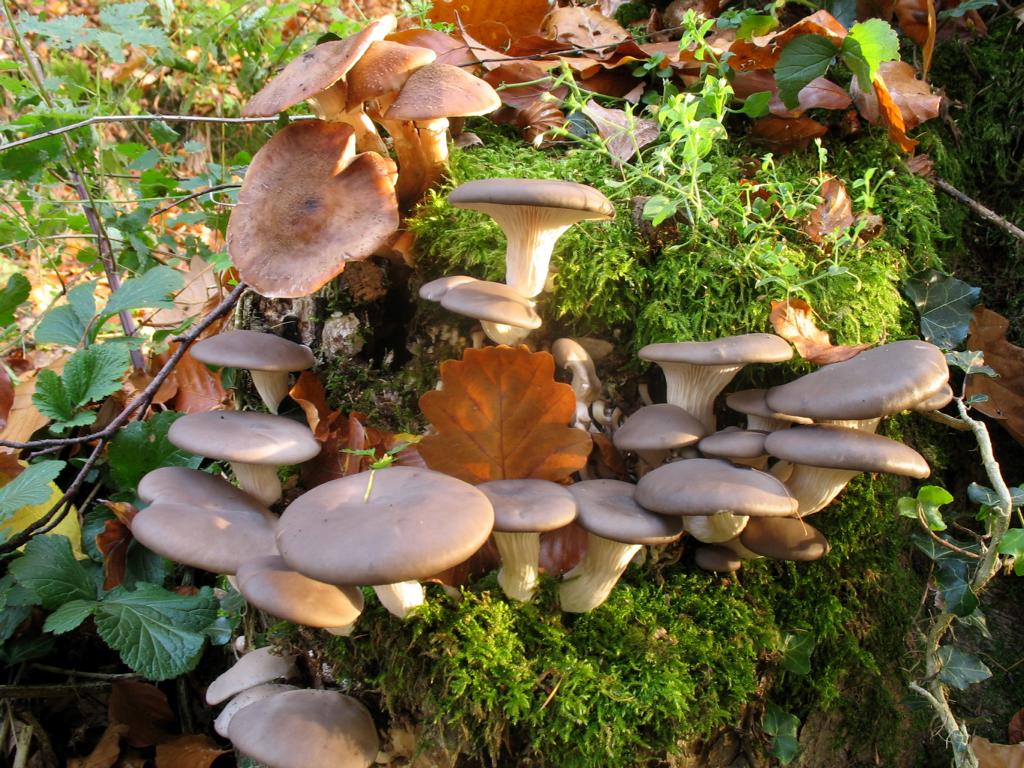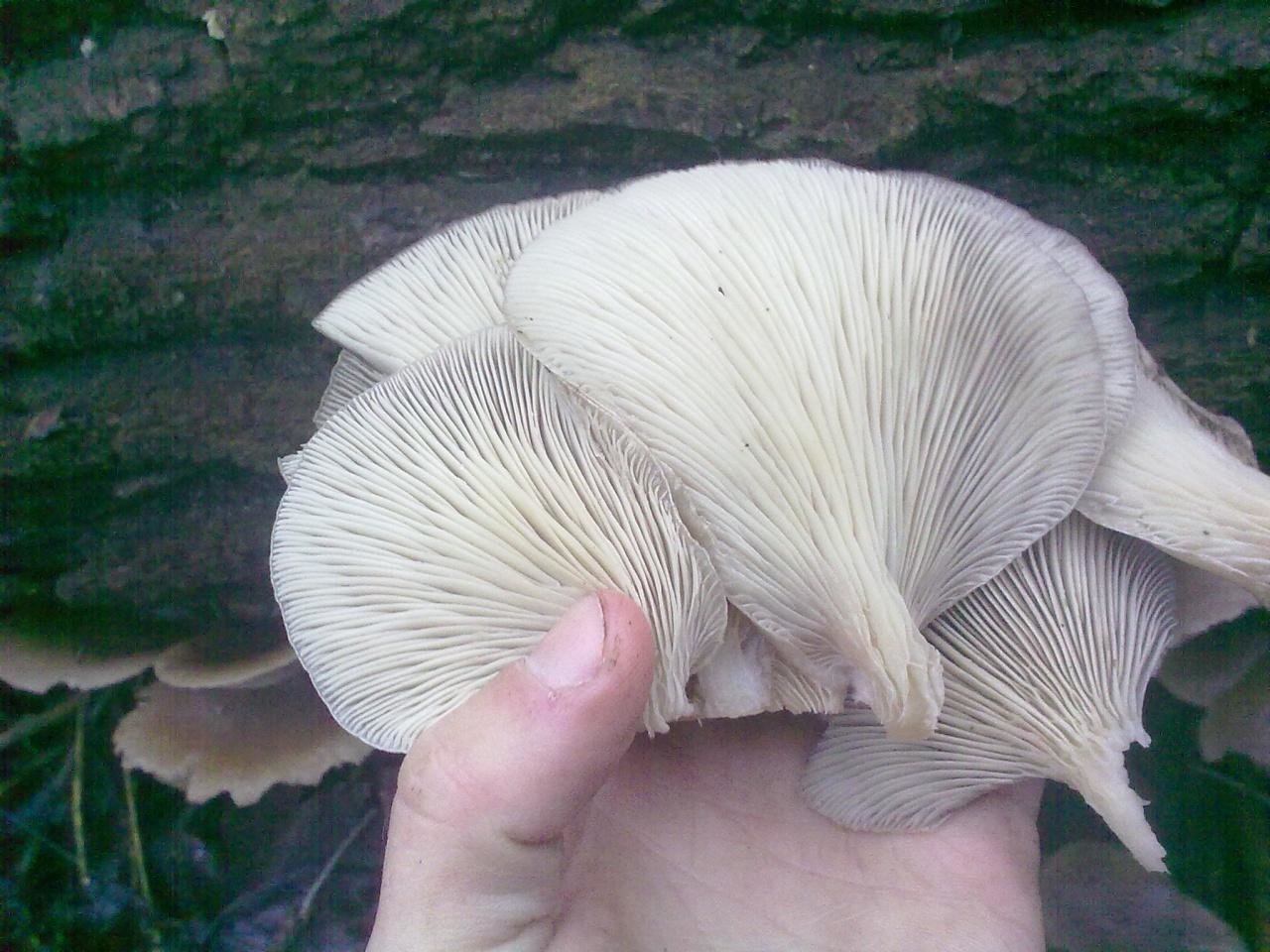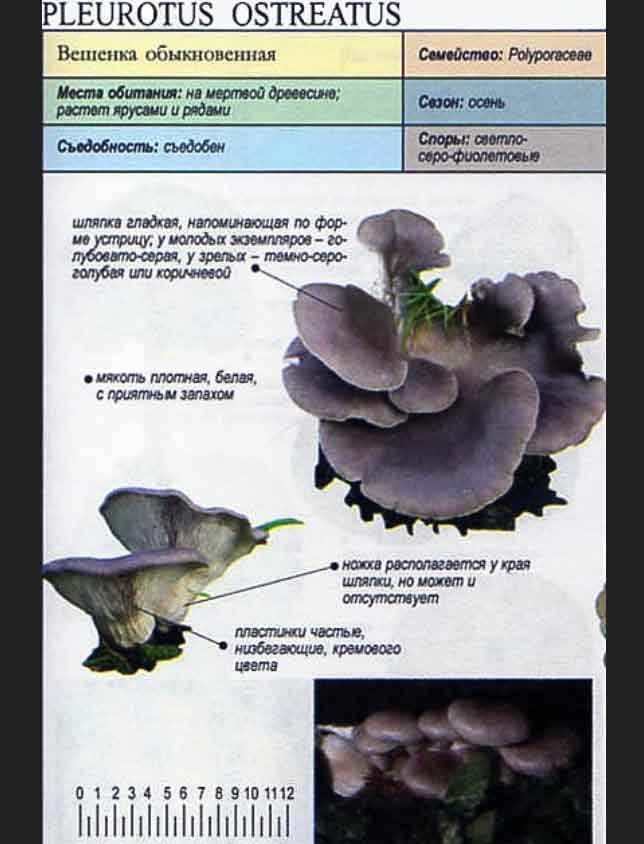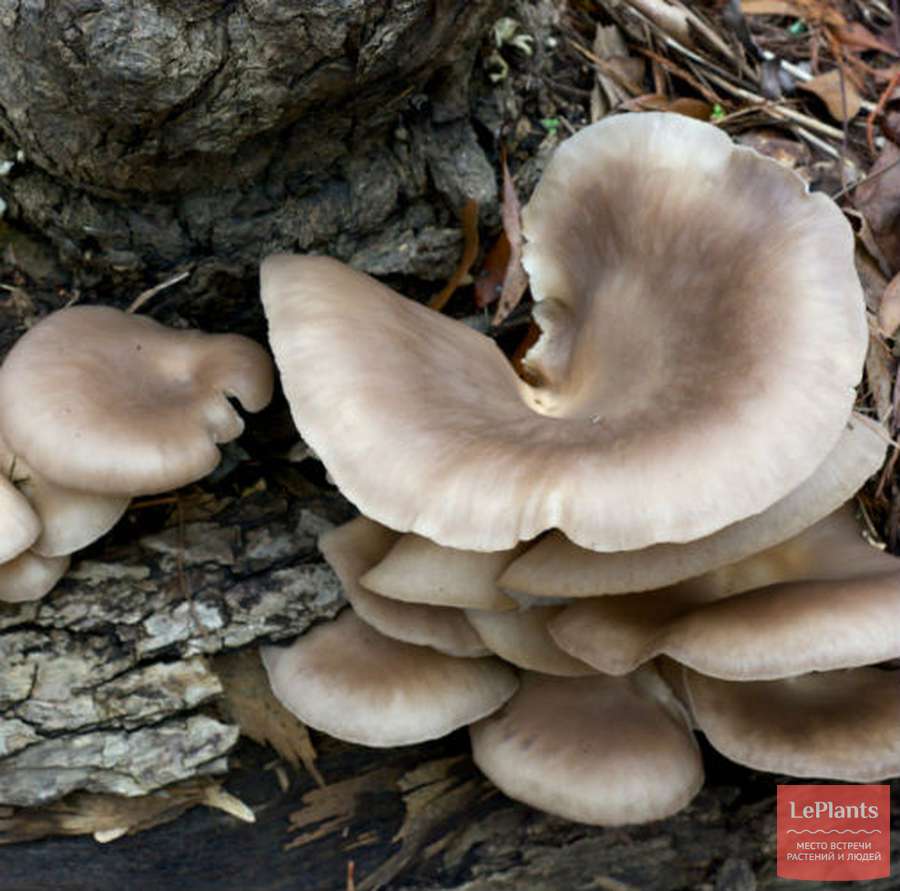Oyster mushroom, Pleurotus ostreatus
Hat: Rounded eccentric, funnel-shaped, ear-shaped, usually with rolled edges, matte, smooth, can take on any shades in the range from light ash to dark gray (there are light, yellowish, and “metallic” variants). Diameter 5-15 cm (up to 25). Several caps often form a fan-shaped, multi-tiered structure. The flesh is white, dense, becomes rather tough with age. The smell is weak, pleasant.
Hymenophore: The plates descending along the stem (as a rule, do not reach the base of the stem), rare, wide, white in youth, then grayish or yellowish.
Spore powder: White.
Leg: Lateral, eccentric, short (at times almost imperceptible), curved, up to 3 cm in length, light, hairy at the base. Older mushrooms are very tough.
Spreading: Grows on dead wood and weakened trees, preferring deciduous trees. Mass fruiting, as a rule, is observed in September-October, although under favorable conditions it can appear in May. Oyster mushroom courageously fights the frost, leaving behind almost all edible mushrooms, except for the winter mushroom, Flammulina velutipes. The “nesting” principle of the formation of fruit bodies actually guarantees a high yield.
Similar species: Oyster mushroom can, in principle, be confused with oyster mushroom, Pleurotus cornucopiae, from which it differs in a stronger constitution, a darker cap color (except for light varieties), a short stem and plates that do not reach its base. Oyster mushroom is also distinguished from oyster mushroom whitish or pulmonary, Pleurotus pulmonarius by its dark color and more solid structure of the fruiting body; from oyster mushroom, Pleurotus dryinus - no private bedspread. Quite inexperienced naturalists may also confuse oyster mushroom with the so-called autumn oyster mushroom, Panellus sirotinus, but this interesting mushroom has a special gelatinous layer under the skin of the cap that protects the fruiting body from hypothermia.
Edibility: The mushroom is edible and even tasty when young. Artificially cultivated (whoever goes to the store saw it). Mature mushrooms become tough and tasteless.
Author's notes: Surprisingly, but true: I first encountered the most common oyster mushroom only when I myself wanted it. Deliberately collided. I remembered in early September that I had never actually seen oyster mushroom in the field (shame!), And went in search of
I had to search for a long time: only on the way back, passing by a huge broken willow growing (or rather, rotting) at my gate, I noticed the strange gray "ears" defiantly bulging on the chopped trunk
Unlike its nondescript counterparts, oyster mushroom made a very serious impression on me. It does not look like a dried pig's ear, or a swollen overgrown chanterelle. Heavy "nests" that do not disintegrate during collection, large cozy burdocks of caps, dense white flesh, homerically huge worms. all these signs set you up for a serious mood. Indeed, not every mushroom knows how to present itself in such a way that you want to grab a whole “nest” (with both hands, you can't drag it off with one) and carry it to show your neighbors - as I actually did.
And oyster mushroom nests can cleverly wriggle out from under the knife and fall with all their weight on the head of a hurried collector, without splitting at all.
In a gloomy snowless winter, on a tree that is still alive, oyster mushrooms do not feel very well. And their bushes are not so bushy, and wither, not reaching an appropriate scope. Nothing. The time will come for them to feast - if, of course, the killed tree is not cut down by the hardworking workers of the park.
A person is accustomed to looking at oyster mushrooms from the bottom up.Unlike mycorrhizal fungi, oyster mushrooms are not very susceptible to the vagaries of the weather, and their inner life, apparently, obeys not very complex and mysterious laws. October came - and the old willow gave birth to oyster mushrooms. It's simple.
An old crippled willow suddenly gave birth to oyster mushrooms. Big and small, young and old. Curiously, on the gray-green mossy trunk it was not so easy to see these protruding mushroom ears.
Description
In Russian, Oyster mushroom is also called Oyster Oyster mushroom, Oyster mushroom and even Tiled Pleurotus (tracing paper from the Latin name of the species Pleurotus ostreatus, adopted in classical taxonomy). Ukrainians call this mushroom Gliva Lisova, but in Russian this name is used extremely rarely.
Oyster mushrooms are very common in nature in the temperate zone and you can safely take them into your basket without fear that you are taking a mushroom from the Red Book. They are unpretentious and easily grown both in industrial conditions and at home or in the country.
In supermarkets, oyster mushrooms cost 300-350 rubles per kilogram, but bulk mushrooms can be bought from farmers and private owners much cheaper: at 110-150 rubles per kilogram. Not to mention the fact that almost all year round they can be collected in the forest for free, or, having once bought an inexpensive mycelium and equipped a place, grow this tasty and healthy mushroom yourself.
Hat
Oyster mushroom grows in colonies in which they are arranged in tiers. The caps of these mushrooms are fleshy, funnel-shaped, and sometimes rounded. By its size, you cannot determine its age of the pleurotus, but by its color - quite. In young mushrooms, the cap is dark gray, in middle age it has a purple tint. But the old ones have nice whitish-yellow hats. They are already tough, contain a lot of chitin and are not suitable for food.
Hymenophore
The hymenophore is a spore-bearing part. Everyone knows that mushrooms are divided into lamellar (like a lump) and tubular (for example, white). This is the simplest division, and according to it, oyster mushrooms are classified as lamellar mushrooms. But in order to accurately distinguish the delicious oyster mushroom from those that will ruin your dish (although it will not be able to greatly harm your health), you need to know the subtleties. The plates of the common oyster mushroom are not very frequent, sometimes even rare, and rather thin. They run along the leg, forming bridges around it. In young mushrooms, the plates are whitish, with age they turn yellow, and sometimes turn gray. Spore white or pinkish powder.
Pulp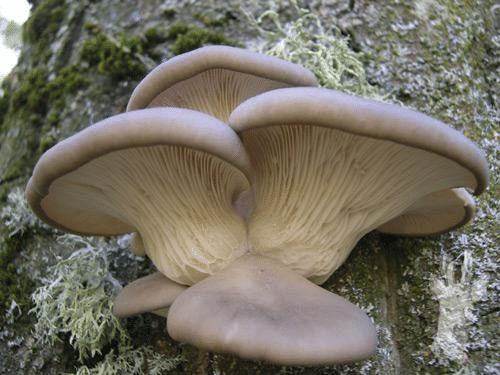
The cap of the common oyster mushroom is white on the cut, soft, but not loose. With age, it becomes more rigid, and by the old age of the fungus, even fibrous. The oyster mushroom does not have a pronounced smell, but its taste is slightly anisic.
Leg
Fortunately for the culinary experts, the oyster mushroom legs, which are inedible due to their rigidity, are very short, sometimes barely distinguishable. They are white, taper towards the base and change color to brown.
Time and place of fruiting Oyster mushroom
Oyster mushroom grows in temperate forests. Colonies appear on dead or diseased trees, stumps, fallen trunks. The oyster mushroom prefers deciduous trees - mountain ash, oak, willow, aspen or birch. On conifers it is very rare and only in mixed forests, you will not find oyster mushrooms in a pure forest. If the colony has grown on a trunk, it will be high enough off the ground, but not so far out of reach.
For the formation of fruit bodies (which, in fact, we eat), oyster mushrooms need cool weather, but not frost. The easiest way to find this mushroom is in late September-October, but whole colonies can be found in November-December. If April, May and June are not hot, pleurotus may have a second peak of fruiting, not as high as in autumn.
What does elm oyster mushroom look like (with photo)

Elm lyophyllum, or elm oyster mushroom (Lyophyllum ulmarium) is extremely rare in winter. In fact, they are edible in the same way as common oyster mushrooms, but difficult to access due to their high location on tree trunks.
In winter, they most often remain on the bends of oak trees, often at a height of more than one and a half meters. Their external state depends on the moment at which frost caught them.If by the onset of freezing temperatures the weather was not wet, and oyster mushrooms reached their maximum growth, then they will remain so throughout the winter. In a thaw, they can wither, their edges can become even more wavy, and individual mushrooms from light brown become brown-black and completely wither.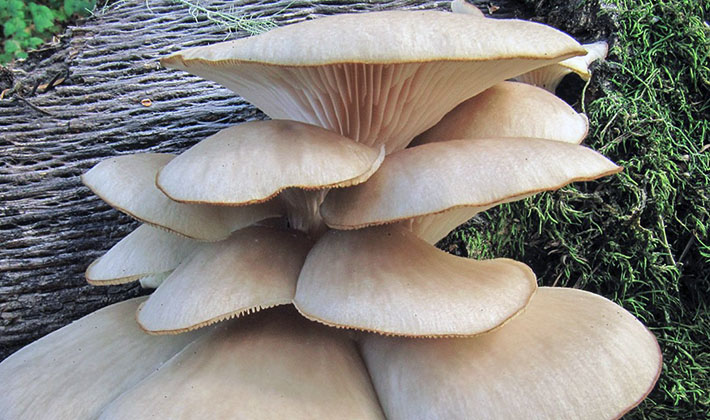
These mushrooms are the largest among the edible winter mushrooms, with an average cap diameter of 10-20 cm.
Habitat: deciduous forests, parks, on stumps and trunks of oak, elm, elm and other deciduous trees, singly or in small groups.
The hat has a diameter of 5-15 cm, sometimes up to 20 cm, first convex, later extended.
As you can see in the photo, a distinctive feature of this type of oyster mushroom is an unusually beautiful color of the cap, like that of a sunflower - sunny, yellowish-brown, the surface of the cap is leathery, finely rough with water spots:

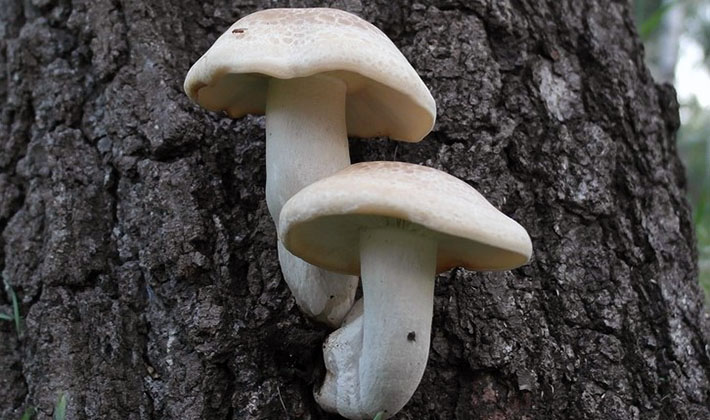
By winter, the surface of the cap becomes yellow-straw and the spots are no longer noticeable. When the mushroom grows on a tree, less often on a stump, it may have an asymmetrical leg arrangement. The edges of the cap are bent downwards, they are wavy. The color at the edges is slightly lighter than in the main part of the cap. In winter, the color changes to straw yellow. Older specimens darken, become black-brown or brown-brown.
The leg is 4-10 cm long, 7-15 mm thick, at first whitish-cream, later yellowish and light brown. The bases of the legs are often fused.
The pulp is soft, gray-lilac, with a mild taste, almost odorless.
The plates are wide, adherent, at first white, later buffy and light brown.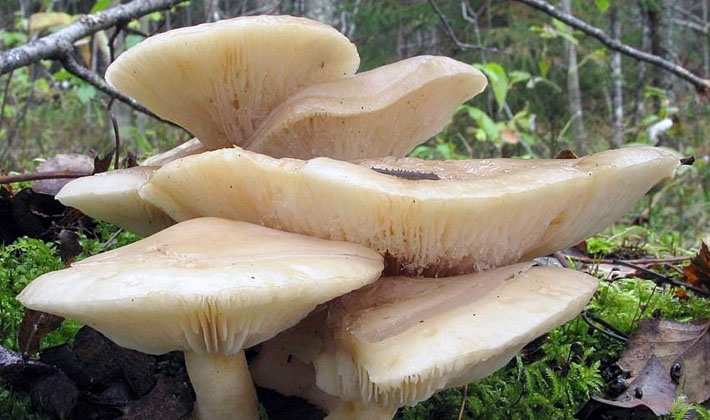
Variability: The color of the cap varies from yellow-golden to dark brown.
Similar species. In autumn, due to its large size and sunny color and watery spots, elm lyophyllum is difficult to confuse with other species. In autumn, this mushroom can be confused in appearance with a crowded row, which differs mainly in its habitat - on the ground, but not in trees. In winter, it does not have similar species.
Cooking methods: boil, fry, salt after preliminary boiling for 15-20 minutes.
Edible, 4th category.
See what the elm oyster mushroom looks like in these photos: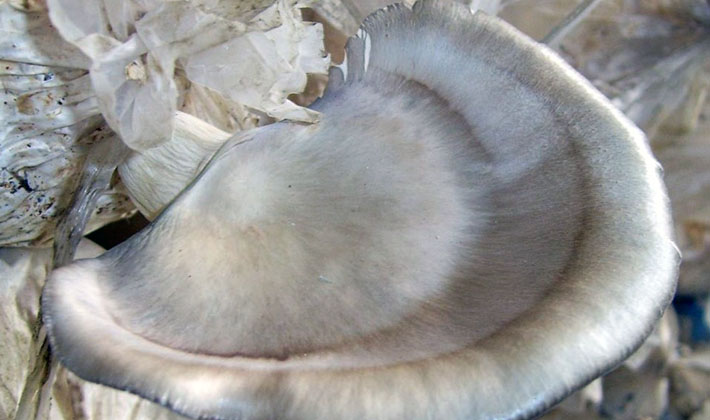

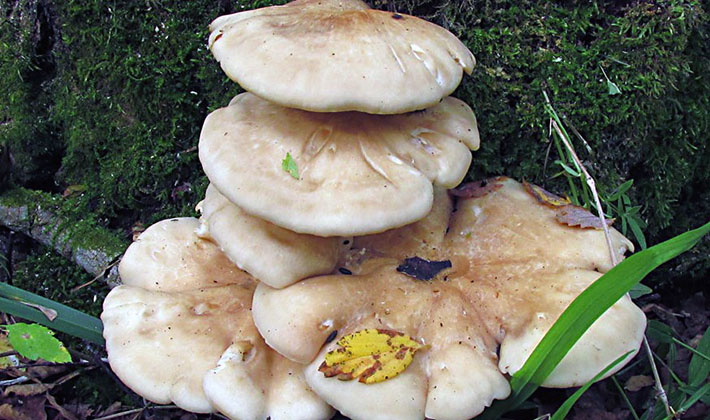
Cooking recipes
Oyster mushroom is easily processed for cooking various dishes.
Cleaning
Mushrooms are filled with water for 15–20 minutes. They are removed from the container with the removal of adhered debris. With the help of a thin sharp knife, dried and spoiled places are removed, the roots are removed. The peeled mushrooms are washed again.
Cooking
Mushrooms are placed in cold water, salt is added. When cooking oyster mushrooms, juice is abundantly released, so the water should barely cover the mushrooms. You can add a little pepper and a clove of garlic. Boil the mushrooms for 15-20 minutes over medium heat. With the help of a colander, allow excess liquid to drain over the sink. Oyster mushrooms are cooked!
Pickling

You will need:
- fresh oyster mushrooms - 1 kg;
- sugar - 2 tbsp. l .;
- salt - 1 tsp;
- onions - 2 large heads;
- garlic - 2 cloves;
- vinegar 9% - 30 ml;
- water - 0.5 tbsp.
Washed mushrooms are cut into pieces, small oyster mushrooms are left intact. Cook in salted water for 15 minutes while preparing the marinade. Stir salt, sugar until dissolved, add vinegar and put chopped chives. Peeled onions are cut into thin half rings, crumpled for juicing.
Put half the onion in a prepared pickling container, with a layer of oyster mushrooms on top. It is poured with marinade, covered with the remaining onion and pressed down by oppression. The further cooking process continues in the refrigerator.
Freezing
Peel and rinse the mushrooms, place on a paper towel, cut into small pieces and dry on the towel again. Place oyster mushrooms on a flat surface and place in the freezer for 4 hours. This action will prevent the mushrooms from sticking together. Transfer to bags and return to the freezer.
Frying
Peeled oyster mushrooms are cut into pieces, laid out in a pan with heated sunflower oil. Add salt and fry until all the liquid has evaporated.
Salting
You will need:
- rock salt - 60 g;
- carnation - 3 buds (inflorescences);
- garlic - 3 cloves;
- dill sprigs with umbrellas - 2 pcs.;
- bay leaf - 1 leaf;
- allspice - 4 pcs.;
- black pepper - 4 pcs.;
- filtered water (for brine) - half a liter.
The legs are separated, leaving a centimeter-long part of the base for the cap. Blanch for about 7 minutes and drain. In dry sterilized jars, the caps are laid out in dense layers.
To prepare the brine, rock salt is poured into boiling water (0.5 liters), peppers, cloves, laurel are added. leaf, sprigs of dill, peeled whole chives. Boil for 7 minutes and filter the brine. Poured into jars and closed with nylon lids. After a week, the product is ready for use.
Canning oyster mushrooms for the winter

Would need:
- oyster mushrooms - 500 g;
- champignons - 500 g;
- large carrots - 2 pcs.;
- garlic - 3 cloves.
Mushrooms are boiled for 8 minutes, adding salt to the water. Allow to drain through a sieve. Larger mushrooms are divided into parts, carrots are rubbed on a fine grater and mixed with mushrooms. For the marinade, pour 4 tablespoons of vegetable oil into the pan, add 1 tsp. chopped paprika, ¼ spoon chopped black pepper, red pepper to taste. All ingredients are quickly fried. Finely chopped garlic is added to mushrooms with carrots, 3 tbsp. l. vinegar. You can add a little sugar, spices are poured into a container with mushrooms. After mixing, they are poured into jars.
Each individual type of mushroom has its own individual composition and taste, appearance. Oyster mushroom is widely used in the preparation of delicacies and is valued for its useful qualities.
Oyster mushroom
| Group: | Lamellar |
|---|---|
| Plates: | White, gray, yellowish |
| Colour: | Bluish-gray |
| Info: | Oyster shell shape |
| Department: | Basidiomycota (Basidiomycetes) |
|---|---|
| Subdivision: | Agaricomycotina (Agaricomycetes) |
| Class: | Agaricomycetes (Agaricomycetes) |
| Subclass: | Agaricomycetidae |
| Order: | Agaricales (Agaric or Lamellar) |
| Family: | Pleurotaceae (Oyster mushrooms) |
| Genus: | Pleurotus (Oyster mushroom) |
| View: | Pleurotus ostreatus (Oyster mushroom) |
Edible mushroom, classified into 2 flavor category
Until recently, oyster oyster mushroom was little known in our country as a commercial mushroom, but they began to pay attention to it since the time when industrially grown oyster mushrooms appeared on store shelves
And it is not for nothing that it is grown in such large quantities, because this mushroom is tasty, prolific and much less demanding on growing conditions than, for example, champignon. However, oyster mushroom can be found not only in the supermarket and mushroom pickers quickly got a taste and began to collect oyster mushroom in the forests.
 Hat
Hat
The sizes of oyster mushroom caps are very different, from 3 centimeters to 15 centimeters, some specimens - up to 20 centimeters at the widest part.
At the beginning of growth, the cap has a round shape with tucked edges, then it stretches along one axis and takes the shape of an oyster shell, which gave the name to this species.
The structure of the cap is dense, dry, elastic. The skin is dry, smooth, matte, tinged with a bluish-gray color, sometimes with a slight violet tinge, in damp weather it becomes covered with a faint white bloom.
Leg
Short, sometimes practically absent, length up to 5 centimeters. Lateral or eccentric, cylindrical or flattened, often strongly curved.
The structure is dense, elastic, the pulp is solid, without voids and cavities, by old age the mushroom becomes hard. The color of the leg is white, slightly brownish at the base, the surface is velvety, with a slight "edge".
Distribution and collection

Grows in deciduous and mixed forests throughout the temperate forest belt. It settles on dead deciduous wood, as well as on weakened trees, accelerating their death. As a rule, it grows in numerous groups, a kind of multi-tiered formations of 20-50 copies at a time. The mass of one joint sometimes reaches 2-2.5 kilograms.
Similar species
Like oyster mushroom, it is edible. It differs in a lighter colored cap, its leg is somewhat longer, the plates of the hymenophore do not fall so low.
Wolf sawnose
Less common than oyster mushroom, the mushroom is not poisonous, but it can ruin the whole dish, as it is very bitter.Its differences are that the plates of the spore-bearing layer of the saw-leaf have characteristic notches, and the pulp has a distinct mushroom smell, while the pulp of the oyster mushroom is devoid of aroma.
Bearish saw-leaf
Easily distinguished by unpleasant pulp odor and serrated lamellar layer

Use
Oyster mushroom is an excellent material for culinary dishes, as it does not require any preliminary processing, is easily cleaned of forest debris and is well stored. It can be cooked fried, boiled, stewed, and canned in marinade or salted. The legs are not eaten due to their rigidity, and long heat treatment makes them even harder.
Interesting Facts

Oyster mushroom is one of the lowest-calorie mushrooms, and the fact that it contains substances that suppress appetite makes it an indispensable product for those who want to lose weight. At the same time, the percentage of assimilation in oyster mushrooms is about 70%, which equates it in nutritional value to meat and legumes.
Beneficial features
The nutritional value of whitish oyster mushroom is not inferior to boletus. It is low in fat and is an excellent dietary product. Its calorie content is about 40 kcal. This mushroom takes a long time to digest in the stomach and creates a feeling of fullness, thereby suppressing appetite.
The fruit body contains about 35 percent protein and a large amount of vitamins, enzymes and minerals that are necessary for the normal functioning of the body. Due to its unique composition, pulmonary oyster mushroom has many medicinal properties. It is protected from the accumulation of harmful substances, therefore it does not contain heavy metal salts.
The benefits of the mushroom for the body are as follows:
- prevention of gastrointestinal ulcer;
- elimination of Escherichia coli;
- removing bad cholesterol from the blood;
- maintaining the functioning of the heart;
- restoration of metabolism;
- cleansing from parasites;
- prevention of atherosclerosis, cholecystitis.
Spring oyster mushroom contains special substances called perforins. They destroy abnormal cells and prevent the development of tumor processes. Therefore, experts recommend using these mushrooms as a preventive measure against cancer. It is helpful to include the product on your menu after chemotherapy. It removes harmful substances from the body. Today, based on this mushroom, many drugs have been developed to suppress cancer cells.
Growing at home in a greenhouse and in the country in the garden
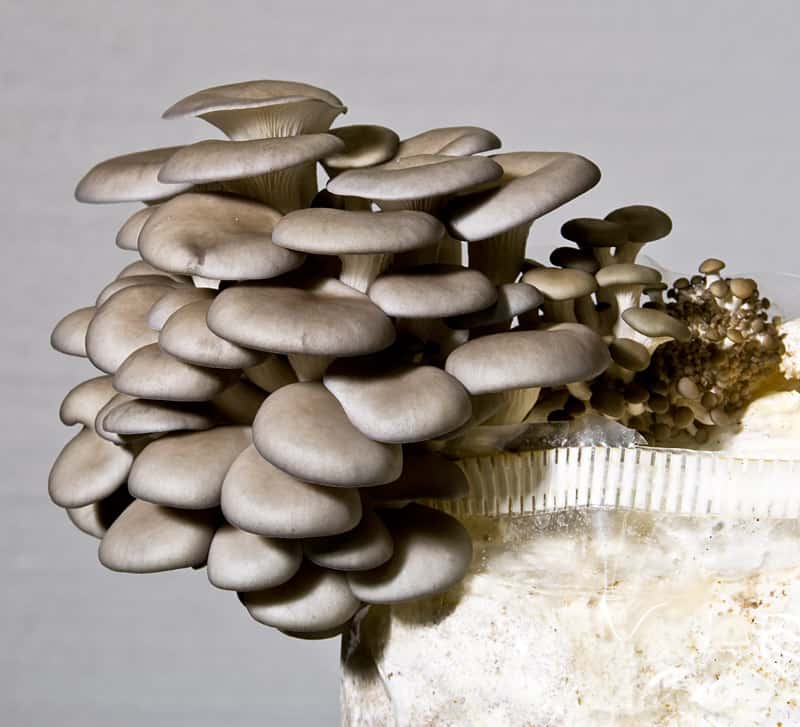
It is easy and inexpensive to grow oyster mushrooms yourself. He needs a humidity of 80-95%, a temperature range of 9 to 25 ° C and very little area. On 1 m2, you can place 4-5 blocks of mushrooms, each of which will yield 2-3 kg of fruit 10 times a year. In fact, in such conditions, the oyster mushroom grows by itself. Where the mushrooms go to grow, you choose. Options are stumps, tree fragments, a special substrate, and even a simple bag of straw. The most difficult thing is to create a microclimate. But if you do not rely on the industrial cultivation of oyster mushrooms, but grow mushrooms for yourself, any stump on the site or a log dug into the ground that can be successfully entered into the landscape will suit you. In a more complex scheme, a basement is ideal, which must be well ventilated, treated from mold, and equipped with fluorescent lamps. The substrate for oyster mushrooms is, in fact, sawdust mixed with straw, buckwheat husks, corn leaves - with any plant residues. The proportions do not matter. All this must be crushed, mixed, put in a vat, filled with water, boiled for 2 hours, and the excess water drained. It remains to fill the appropriate boxes and plant the mycelium (this is done at the same time).
Street stumps are sown at the end of April, covered with earth and covered with polyethylene. The mycelium is placed in cuts 5 cm deep, spaced at least 30 cm apart.Bags or boxes with the substrate are filled with a sawdust-straw mixture in layers: 5 cm of the nutrient medium - half a centimeter of mycelium, and so on until filling
It is important not to forget to make small cuts in the container for the exit of the mushroom blocks.
Wash your hands (or gloves) before sowing, warm the mycelium to room temperature before planting, and then success is almost guaranteed. First of all, violations of the microclimate, the appearance of mold due to non-compliance with the rules of hygiene can interfere with it.
Oyster mushroom (Pleurotus pulmonarius) - Mushrooms of Siberia
Current title
| Index Fungorum | Pleurotus pulmonarius (Fr.) Quél. |
| MycoBank | Pleurotus pulmonarius (Fries) Quélet |
Systematic position
Fungi, Basidiomycota, Agaricomycetes, Agaricales, Pleurotaceae, Pleurotus
Etymology of the species epithet
Pulmonarius, a, um patient with lungs; healing for the lungs.
Synonyms
- Agaricus pulmonarius Fr., Syst. mycol. (Lundae) 1: 187 (1821)
- Dendrosarcus pulmonarius (Fr.) Kuntze, Revis. gen. pl. (Leipzig) 3 (2): 464 (1898)
- Pleurotus araucariicola Singer, Lilloa 26: 141 (1954)
Other names: Whitish oyster mushroom, Spring oyster mushroom, Beech oyster mushroom.
Habit
Hat
The cap is 3-10 cm in diameter, ear-shaped, lobed or irregular in shape, slightly concave-outstretched or convex, with a straight or wavy sharp edge, sometimes slightly turned up, smooth or rarely scaly, often with radial hygrophane zones, white, cream, grayish, ocher, or the color of coffee with milk.
The plates are descending, frequent, narrow, with plates, with rare anastomoses and an even, wavy or finely toothed edge, white, grayish or creamy, often with greenish or lemon-yellow spots.
The blanket is missing.
Leg
Stem 1 - 4 cm long, 0.5 - 2 cm in diameter, short or completely absent, lateral or eccentric, cylindrical, solid, white, pubescent at the base.
Pulp
Microscopy
Spores 7.5 - 12 × 3 - 4.5 µm, ellipsoidal, sometimes slightly almond-shaped, unequal, smooth, thin-walled, not amyloid, white, yellowish or grayish in mass.
Basidia 20 - 30 × 5 - 8 μm, clavate, 2 or 4 spore, with a buckle at the base.
Pleurocystids 20 - 50 × 2 - 4.5 µm, cylindrical with a slightly swollen apex.
Cheilocystids were not found.
Ecology and distribution
Substance: Woody plants (living trees, bark and dead wood)
Grows in groups, rarely singly on dying or dead deciduous trees. Recorded on alder (Alnus), birch (Betula), aspen, poplar (Populus), willow (Salix).
Fruiting
May - September.
The divisions correspond to the decades of the month.
Nutritional properties
Edible
Should be harvested with care due to its resemblance to pleurocybella, a potentially poisonous fungus. Similar species
Similar species
- Oyster mushroom (Pleurotus ostreatus) - has fleshy fruiting bodies with a brighter color.
- The protruding pleurocybella (Pleurocybella porrigens) is an outwardly indistinguishable fungus from the Marasmiaceae family. Differs in a mealy, not mushroom smell, a slightly more fragile habit and growth on coniferous wood. Until recently, it was generally accepted as edible, but studies conducted after a series of severe and fatal poisoning in Japan in 2004 identified a potential toxin - the unusual amino acid pleurocybellaziridine.
Notes
Causes white rot.
Oyster mushroom, as well as Oyster mushroom (Pleurotus ostreatus), is cultivated on an industrial scale.
Distribution in Western Siberia
Everywhere in birch and birch-aspen forests.
Related materials
- Zmitrovich I.V., Malysheva V.F., Malysheva E.F., Spirin V.A.Pleurotoid fungi of the Leningrad region. - SPb .: "VIZR", 2004. - 124 p. - S. 96.
- Bas C., Kuyper Th. W., Noordeloos M. E., Vellinga E. C. Flora Agaricina Neerlandica. Critical monographs on families of agarics and boleti occurring in the Netherlands. Vol. 2. Pleurotaceae, Pluteaceae, Tricholomataceae. - Rotterdam - Brookfield: A. A. Balkema, 1990 .-- 160 p. - P. 21.
- Beug M. Pleurocybella porrigens toxin unmasked? - North American Mycological Association. Url:
Benefits for the body
The pulp of the horn-shaped oyster mushroom contains many useful substances necessary for the normal functioning of the body. Among them:
- vitamins of group B, C, E, PP;
- minerals - potassium, iodine, calcium, iron;
- amino acids - valine, threonine, leucine.
Mushrooms are recommended for people who have the following health problems:
- diabetes;
- obesity;
- poor metabolism;
- mastopathy;
- weak immunity;
- tumor formations;
- insomnia;
- nervous disorders;
- cholecystitis;
- atherosclerosis;
- hypotension;
- thrombophlebitis;
- hypertension.
Tinctures and elixirs for oral administration are made from oyster mushroom. Its juice is an excellent base for cosmetic masks.
To prepare a tincture for mastopathy, pour 500 g of oyster mushrooms with a liter of alcohol. The container is placed in a cool place, protected from light, for ten days. Take the medicine one tablespoon once a day before meals. The course of therapy is 1 month. As a preventive measure, two weeks are enough.


